
 Credit: Photographer: lisasolonynko. Source: morguefile.com. All rights reserved.
Credit: Photographer: lisasolonynko. Source: morguefile.com. All rights reserved.
It is always hard to get dogs with kidney failure to eat regular and nutritional meals. This is even more difficult because owners need to carefully control the amounts of phosphorus, sodium, low-quality protein and other elements normally found in standard dog food products.
Manufactured renal dog foods are often unpalatable and many of our best friends simply refuse to go near them. Most will offer them a sniff, but that's it. In these cases, the answer is to try home-cooked meals made up of nutritional and beneficial ingredients that won’t cause further kidney damage.
If you try these recipes, please make the change from your dog’s regular food slowly and incrementally and after introducing both antacid and anti-nausea medication. It’s also worth mentioning that four or five small meals a day cause less stress on the kidneys than one or two larger meals. In all cases, please consult your vet and ask about adding multivitamins or specific minerals to the diet (the type and nature of supplements will depend on current blood level results). It is also prudent to mention that both diet and chronic kidney failure go together with the changes that occur during a typical progression of the disease, so these recipes may need adapting for your own dog's blood values.
These are some of my own recipes worth trying. They all contain a good balance of nutrients and have elements that should encourage a dog to start eating properly again. Careful attention has been given to include meats, fish, vegetables, fruit and additives considered more suitable for dogs with kidney failure. If you have problems finding ingredients such as barley, sticky (glutinous) rice or rice flour at your local supermarket, try looking in specialist Asian, Indian or Chinese shops and always buy organic varieties, if you can.
Most of these recipes will make enough meals for a medium-sized dog over two to three days. A nutritional breakdown has been given for each recipe, but owners should refer to the amount of each meal being given and calculate a nutritional breakdown based on what is right for the size and breed of dog. Importantly, omit any adverse ingredients according to current blood level results. For example, if a dog has high potassium, potatoes are best replaced with something more appropriate containing less potassium.
1. Chicken with Egg
Ingredients: Chicken leg meat (280g human grade), two free-range eggs, two medium-sized potatoes (400g), 1 tablespoon of chicken fat (juice from cooking the chicken), 1 tablespoon of chopped cooked cabbage, 2 teaspoons of pure 100% organic salmon oil.
 Credit: Tony Booth.
Credit: Tony Booth.
Dry-roast the chicken leg, ideally with the skin on. Keep the juice from cooking the chicken. Allow everything to cool, then cut the chicken meat into small pieces, being careful to remove all the bones. Peel and then boil the potatoes (potato skin has oxalates in it, which are harmful to the kidneys). Allow to cool and then cut into cubes. Don’t use green potatoes, as these also have a toxic compound called solanine. Allow to cool and then cut into cubes. Boil the cabbage and chop finely. Cabbage is useful, as it helps prevent stomach ulcers forming and is a beneficial fermentable fiber. Hard-boil the eggs, but only use one of the yolks (egg white has less phosphorus than the yolks), then chop and mix all the ingredients together. Drizzle the salmon oil over the top.
Note: Finely crushed dried egg shells are a natural (calcium-based) phosphate binder and can often be used to good effect with kidney failure in dogs. However, always seek veterinary approval before using egg shells in this way, because the health and safety of this technique depend on the level of calcium, phosphate and potassium in recent blood results. One dried and finely crushed egg-shell produces about a teaspoon of calcium carbonate and half a teaspoon is enough for a pound of food.
Independent researcher Dr. Doug Bibus (formerly of the University of Minnesota) completed a fatty acid study with dogs and he recommends a ratio of between 2:1 and 4:1 omega-6 to omega-3. Most canine pet food products range in ratios of 5:1 to 10:1.
The cooked ingredients will last three days in a sealed container in the refrigerator.
Nutritional Data for the completed recipe: Total Calories = 1175. Phosphorus 734mg; Potassium 2133mg; Sodium 384mg; Calcium 80mg; Iron 5.4mg; Omega-3 Fatty Acid 3821mg; Omega-6 Fatty Acid 8122mg; High Quality Protein 91.2g; Carbohydrates 82.8g; Magnesium 157mg; Saturated Fat 12.2g; Selenium 82.4mcg.
2. Chicken with Vegetables
Ingredients: 1 medium-sized chicken leg (280g human grade), 1 tablespoon of chicken fat from cooking the chicken, 50g green beans, 200g carrots, 400g sweet potato (but only if your dog’s potassium levels are within normal range), 60g broccoli (but only if your dog’s potassium levels are within normal range), 1 teaspoon of pure coconut oil.
 Credit: Tony Booth.
Credit: Tony Booth.
Dry-roast the chicken leg, ideally with the skin on. Dark chicken meat is better for dogs with kidney disease, as it has more fat. Keep the juice from cooking the chicken. Allow everything to cool, then remove the chicken meat from the bones. Cut the vegetables into small pieces and steam for 10 minutes (cooking the vegetable makes them more digestible for dogs and it also helps release some of the phosphorus in them). Once everything is cool, mix together and drizzle warmed coconut oil over the top (pure coconut oil is solid and needs warming in a container placed in hot water to melt it).
The cooked ingredients will last 3 days in a sealed container in the refrigerator.
Nutritional Data for the completed recipe: Total Calories = 1077. Phosphorus 730mg; Potassium 2269mg; Sodium 493mg; Calcium 248mg; Iron 7.8mg; Omega-3 Fatty Acid 694mg; Omega-6 Fatty Acid 7809mg; High Quality Protein 83g; Carbohydrates 96g; Magnesium 178mg; Saturated Fat 14.8g; Selenium 62mcg.
3. Green Tripe with Sticky White Rice, Apple & Cucumber
Ingredients: 200g frozen green tripe, a cup of dry sticky white rice, half an apple (peeled and de-seeded), 3 chunky slices of cucumber (cut into quarters).
 Credit: Tony Booth
Credit: Tony Booth
Green tripe is a great source of essential nutrients and high-quality protein. Frozen blocks are sometimes hard to find, but many good pet stores now sell it in their freezer departments. Always confirm it is green tripe intended for dogs and not white tripe intended for human consumption, as the latter is normally bleached and harmful to dogs. Green tripe is low in phosphorus, but it has useful enzymes that help purify the blood and remove toxins. Cooking tends to destroy the enzymes, so part-cooking is better (raw even more so, but use caution because some dogs cannot tolerate raw foods).
The best way of cooking the green tripe is in a microwave. Cut into 100 gram blocks, place in a loosely covered glass dish and microwave at 30% power for between 10 and 12 minutes, depending on the power of the microwave appliance. Break into small pieces and save the juice for later. Make sure the tripe has cooled completely before using. Green tripe stinks while cooking, but most dogs absolutely love the taste of it.
Cut the apple and cucumber into bite-size pieces and mix with the tripe and cooked sticky white rice. White rice has less phosphorus than brown rice and sticky white rice has the lowest phosphorus of any grain other than tapioca, which is quite hard to find these days. Finally, drizzle the cooled tripe juice over the top before serving. This recipe is not suitable for storing, as the apple and cucumber spoil quickly. So, omit these two ingredients until serving, if you want to store for up to three days in a refrigerator.
This recipe is not suitable as everyday dog food, as it lacks the calories and carbohydrates, but it is useful as a tasty occasional meal that most dogs find irresistible.
Nutritional Data for the completed recipe: Total Calories = 402. Phosphorus 157mg; Potassium 311mg; Sodium 142mg; Calcium 185mg; Iron 1.87mg; Omega-3 Fatty Acid 28mg; Omega-6 Fatty Acid 422mg; High Quality Protein 28.3g; Carbohydrates 52g; Magnesium 53.3mg; Saturated Fat 2.8g; Selenium 33.8mcg.
4. Beef with Butternut Squash
Ingredients: 200g of minced beef (human grade), 200g butternut squash, 50g green beans, 50g chopped cabbage, 70g dried pasta, 2 teaspoons of natural (organic) honey.
 Credit: Tony Booth.
Credit: Tony Booth.
Cook the beef in a pan with 2 tablespoons of water and set aside to cool. Beef is high in fat, which helps provide both nutrition and energy for dogs with kidney failure. It also has less phosphorus than chicken, making it sometimes a better option when other ingredients have some phosphorus in them. Do not be tempted to buy lean minced beef, as the fat content is good for dogs with kidney failure (unless there's a diagnosis of pancreatitis).
Peel off the skin of the butternut squash and cut the flesh into small cubes. Steam the butternut squash, green beans and cabbage until tender. Cook the pasta in boiling water for 13 minutes, drain and then place in cold water to cool it completely (this stops it from overcooking or drying out while you prepare the rest of the meal). Mix all the cooked ingredients together with the stock from cooking the beef and drizzle with the honey before serving.
The cooked ingredients will last 3 days in a sealed container in the refrigerator.
Nutritional Data for the completed recipe: Total Calories = 824. Phosphorus 561mg; Potassium 1445mg; Sodium 140mg; Calcium 155mg; Iron 7.35mg; Omega-3 Fatty Acid 489mg; Omega-6 Fatty Acid 1263mg; High Quality Protein 57.8g; Carbohydrates 60g; Magnesium 149mg; Saturated Fat 15.7g; Selenium 43.6mcg.
5. Mackerel with Sticky Rice
Ingredients: 80g of tinned mackerel drained of oil (olive oil is better than sunflower oil), 50g sticky white rice (sushi rice), 150g sweet potato, two free-range eggs, 2 teaspoons of pure (organic) salmon oil.
 Credit: Tony Booth.
Credit: Tony Booth.
The bone in tinned fish is high in phosphorus, so only use a very small amount of the drained mackerel (three heaped tablespoons are adequate for one meal). Never buy tinned fish that is in either safflower or cod liver oil, as these make kidney disease deteriorate. Tinned salmon in oil is a suitable substitute for variety with this recipe.
Cook the sticky white rice in a small amount of unsalted butter and leave to cool. Peel and cut the sweet potato into small cubes, steam for 5 minutes and leave to cool. For larger dogs, increase the amount of sticky rice and sweet potato by equal measures. Hard boil the eggs, remove and discard the yolk from one of the eggs and chop the remaining two egg whites and one yolk. Mix all the ingredients together and drizzle the salmon oil over the top.
The cooked ingredients will last 3 days in a sealed container in the refrigerator.
Nutritional Data for the completed recipe: Total Calories = 411. Phosphorus 350mg; Potassium 797mg; Sodium 227mg; Calcium 80mg; Iron 3mg; Omega-3 Fatty Acid 2771mg; Omega-6 Fatty Acid 911mg; High Quality Protein 32g; Carbohydrates 38.5g; Magnesium 115mg; Saturated Fat 6g; Selenium 66mcg.
6. Pork with Yogurt
Ingredients: 200g of minced or untrimmed pork (human grade), 1 tablespoon plain organic yogurt, 130g barley, 400g sweet potato, 100g carrot, 2 teaspoons of natural honey.
 Credit: Tony Booth.
Credit: Tony Booth.
Barley is a natural fermentable fiber, which has some beneficial properties for dogs with kidney failure. Rice bran can also be used as a substitute. Yogurt is also useful as a probiotic and provides a tasty occasional treat (never use flavored or artificially sweetened yogurt, as these are harmful to dogs). Omit the yogurt from this recipe and trim the pork of any fat if your dog suffers from pancreatitis.
Cook the pork and allow to cool, keeping any juices back to mix with other ingredients later. Chop into small cubes, if you are using joint cuts. Boil the barley in 2 cups of water for 40 minutes, leave to cool and drain. Cut the vegetables into bite-size pieces and steam for 5 minutes. Mix all the ingredients together with the yogurt. Drizzle honey over the top and serve.
The cooked ingredients will last 3 days in a sealed container in the refrigerator, but omit the yogurt and honey.
Nutritional Data for the completed recipe: Total Calories = 1030. Phosphorus 787mg; Potassium 2054mg; Sodium 301mg; Calcium 195mg; Iron 7mg; Omega-3 Fatty Acid 128mg; Omega-6 Fatty Acid 3092mg; High Quality Protein 68g; Carbohydrates 129g; Magnesium 166mg; Saturated Fat 10.8g; Selenium 107mcg.
7. Hamburger and Rice
Ingredients: 220g hamburgers or beef burgers (human grade and with no added salt, onions, herbs or spices), 100g of dry white rice, 50g green beans, 200g sweet potato, 1 teaspoon of pure coconut oil.
 Credit: Tony Booth.
Credit: Tony Booth.
Grill the burgers, keeping the meat juices to mix with other ingredients later. Once the burgers are cool, cut into small bite-size pieces. Boil the rice for 15 minutes or until cooked, rinse in cold water and leave to drain. Steam the beans and cubed sweet potato and leave to cool. Mix all the ingredients together and drizzle the coconut oil over the top.
The cooked ingredients will last 3 days in a sealed container in the refrigerator.
Nutritional Data for the completed recipe: Total Calories = 908. Phosphorus 537mg; Potassium 1206mg; Sodium 181mg; Calcium 104mg; Iron 8.3mg; Omega-3 Fatty Acid 2034mg; Omega-6 Fatty Acid 1261mg; High Quality Protein 58.7g; Carbohydrates 68g; Magnesium 103mg; Saturated Fat 16.7g; Selenium 48mcg.
8. Sardines with Pasta
Ingredients: 80g of tinned sardines in water (do not buy sardines in oil or in water that has salt), 100 grams dried pasta shapes, 50g chopped cabbage, 40g frozen peas, 1 teaspoon of pure salmon oil.
 Credit: Tony Booth.
Credit: Tony Booth.
Drain and chop the sardines. Cook the pasta shapes by boiling in water for 15 minutes, rinse under running cold water and drain. Steam the cabbage and peas for 10 minutes and leave to cool. Mix all the ingredients together. Drizzle the salmon oil over the top before serving.
The cooked ingredients will last 3 days in a sealed container in the refrigerator.
Nutritional Data for the completed recipe: Total Calories = 375. Phosphorus 513mg; Potassium 484mg; Sodium 435mg; Calcium 338mg; Iron 3.3mg; Omega-3 Fatty Acid 1743mg; Omega-6 Fatty Acid 3014mg; High Quality Protein 32g; Carbohydrates 36g; Magnesium 85mg; Saturated Fat 2.3g; Selenium 45mcg.
9. Sweet Potato Treats
Standard dog treats often contain a huge range of unwanted and potentially harmful elements, including salt, phosphates, artificial colorants, flavorings and preservatives. Most dogs love the taste of sweet potatoes, which is great as they are low in phosphorus but rich in vitamins E and B6, potassium and iron. This recipe turns sweet potatoes into a safe and tasty and either a soft or more crunchy occasional treat, depending on preparation.
Ingredients: 250g sweet potato, 50g unsalted butter.
 Credit: Tony Booth
Credit: Tony Booth
Peel the sweet potato (the skin has the most phosphate in it, so it’s worth removing) and cut the flesh into half-inch slices for softer treats or quarter-inch slices for something more crunchy. Pre-heat the oven to 250 degrees Fahrenheit or 130 degrees Celsius. Line a baking tray with grease-proof paper smeared with a little unsalted butter. Place the sweet potato slices on the paper and brush the tops with a little melted unsalted butter. Bake for three to three and a half hours. The thicker slices are better for older dogs that may have dental issues, as they don’t need much chewing. Turn the sweet potato pieces every hour to get all-around baking and to prevent them sticking. Once cooked, turn them out on a wire rack and leave overnight to cool and harden.
Store in an airtight container.
Nutritional Data per 15g treat: Total Calories = 27. Phosphorus 4.6mg; Potassium 29mg; Sodium 4mg; Calcium 4mg; Iron 0.08mg; Omega-3 Fatty Acid 28mg; Omega-6 Fatty Acid 435mg; High Quality Protein 0.2g; Carbohydrates 2.2g; Magnesium 2.3mg; Saturated Fat 0.6g; Selenium 0.04mcg.
10. BB’s Munchy Muffins
These softer occasional treats are better for older dogs or those with dental issues, as they don’t take much chewing - but taste great. The original recipe these treats came from suggested using wild rice, but I have substituted with plain white rice as it has less phosphorus in it. Another change has been to include dark meat chicken, which is found mainly around chicken legs, because there is more fat content. The increased fat content is very beneficial to kidney failure dogs and provides much-needed energy. Parsley is a useful addition, in small quantities. It helps prevent small stones forming and is rich in antioxidants and vitamin C. However, parsley is also a diuretic, so it’s better not to give more than one of these tasty treats a day.
Ingredients: 1 cup of dark chicken meat (chopped into small pieces), 3 tablespoons rice flour, 1 cup white rice, 1 free-range egg (beaten), 1 tablespoon of fresh (organic) parsley.
 Credit: Tony Booth.
Credit: Tony Booth.
Pre-heat the oven to 350 degrees Fahrenheit or 170 degrees Celsius. Boil the rice in water for 15 minutes, rinse, drain and set aside to cool. Chop the parsley. Add all the ingredients to a bowl and mix until it resembles a sticky dough. Use a non-stick cupcake tray and spoon enough mixture into each hole to fill it. For small dogs, just half fill the cupcake moulds. Press the mixture down firmly to make sure it is well packed into the compartments. Bake for 25 to 35 minutes or until the tops turn light brown. Bake for longer if your best friend likes a crunchy treat. Let the muffins cool completely, then carefully remove from the cupcake tray and store in an airtight container in the refrigerator (where they will keep for 3 days).
If you use fresh chicken instead of frozen, you can safely store the muffins in the freezer for several weeks – but make sure the treats are fully defrosted before giving any to your dog.
Nutritional Data per muffin (if 9 are made with this recipe): Total Calories = 90. Phosphorus 52mg; Potassium 57mg; Sodium 22mg; Calcium 8mg; Iron 0.5mg; Omega-3 Fatty Acid 43mg; Omega-6 Fatty Acid 524mg; High Quality Protein 6g; Carbohydrates 9.5; Magnesium 8.5mg; Saturated Fat 0.8g; Selenium 7.3mcg.
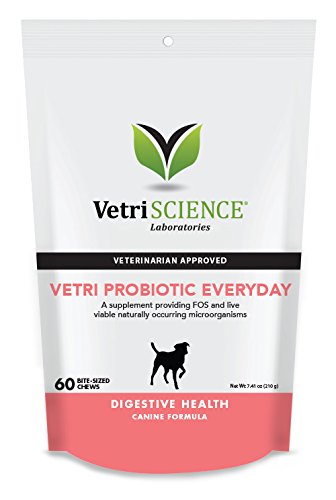 Probiotics for Dogs: Your Dogs Best Friends?
Credit: By Richard Bartz (Own work)
Probiotics for Dogs: Your Dogs Best Friends?
Credit: By Richard Bartz (Own work)
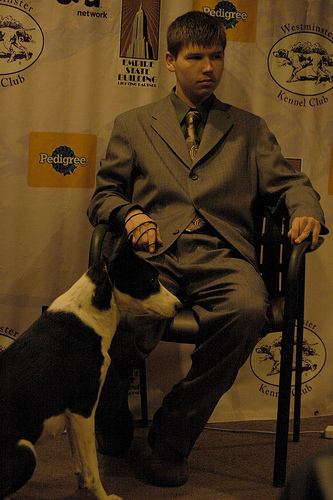 Junior Handler Shows Canaan Dog with Seizure Alert Skill - Westminster 2010
Junior Handler Shows Canaan Dog with Seizure Alert Skill
Junior Handler Shows Canaan Dog with Seizure Alert Skill - Westminster 2010
Junior Handler Shows Canaan Dog with Seizure Alert Skill
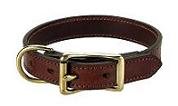 English Bridle Leather Dog Collars
If you have a medium to larg
English Bridle Leather Dog Collars
If you have a medium to larg
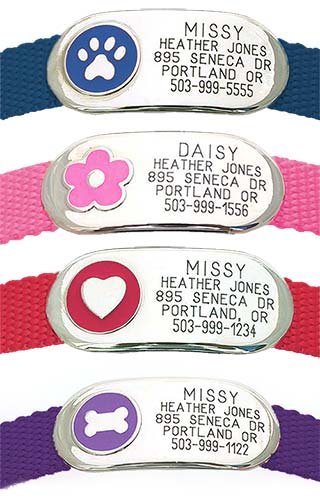 Name Tags for Dog Collars
For most people, our dogs ar
Name Tags for Dog Collars
For most people, our dogs ar
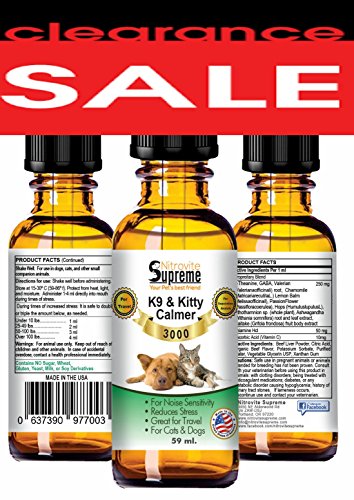 Dog Fear of Thunder and Loud Noises
My dog did not start out sca
Dog Fear of Thunder and Loud Noises
My dog did not start out sca
Copyright © 2005-2016 Pet Information All Rights Reserved
Contact us: www162date@outlook.com